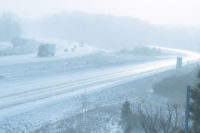
According to OSHA, falls are the leading cause of fatalities in the construction industry and account for roughly 300,000 injuries each year. In addition to the human tragedy, falls take a toll in direct and indirect costs including medical expenses, lost work time, insurance, workers’ compensation and lost productivity.
Today the technology exists for 100 percent fall protection. Unlike incidents caused by acts of nature or another person’s carelessness, you can control workplace falls through the proper use of fall protection equipment and devices.
Identify the hazards
Identifying the hazards is the first step in creating fall protection awareness. Because the construction worksite is an ever-changing environment, it is important to conduct hazard awareness on a regular basis.
There are two types of factors that can cause fall hazards: environmental factors and personal factors. Examples of environmental hazards include wet surfaces, inadequate lighting, weather changes, electrical hazards, and irregular work surfaces. Personal hazards include poor housekeeping, vision problems, illness and the use of medication.
Select the right equipment
Once you have identified the hazards, you can create a plan of action to prevent falls by selecting and using the appropriate equipment. When the danger of falling more than six feet exists, workers must be protected using the method that best matches the working conditions and fall protection requirements for the type of construction tasks being performed.
To eliminate environmental hazards, effective engineering controls vary according to the demands of your worksite. Guard rails, scaffolds, and platforms offer protection from falls and can also safely elevate the work surface to the desired height.
If exposure to fall hazards cannot be safely eliminated or controlled with the use of such devices, then other forms of fall protection, such as personal fall arrest systems, can be selected. A basic fall arrest system includes a full body harness, a connecting device and an anchor point. These three components work together to arrest the fall from a working level. While there are many possible configurations for a personal fall arrest system, the elements you use will depend on your specific job tasks and working environment.
The full body harness is the only acceptable bodyholding device for a personal fall arrest system. When a fall occurs, the harness lessens the jolt to the body by spreading most of the impact forces over the buttocks, thighs, chest and shoulders. Body belts do not prevent the worker from slipping out during a fall, so they are not an acceptable form of fall protection.
The lanyard is the most common type of connecting device. It plays a critical role in the fall arrest system by joining the full body harness to the secure anchorage. There are important considerations and precautions to keep in mind when selecting and using a lanyard. The type you choose depends on the potential fall distance, the work being performed and the work environment. The maximum length of the lanyard must not allow a fall of greater than six feet or allow the worker to come in contact with lower level hazards. It is attached to an anchorage by means that will not reduce its strength, using a locking snaphook. Tying a knot in a lanyard can reduce its strength by 80 percent or more.
The final component of the fall arrest system is the anchorage; a secure point of attachment for the personal fall arrest system. The anchorage point is independent of the means supporting or suspending an employee and must be capable of supporting at least 5,000 pounds for each attached worker. The anchorage should also be reachable for attachment without exposure to hazards and located high enough to prevent the worker from contacting a lower level hazard during a fall. Select an anchorage point that is as high above head level as feasible. This limits free fall distance and minimizes the impact forces generated by the fall. The anchorage should be as close to directly above your head as possible, rather than to one side or the other. This reduces the chances of swinging during a fall. Make sure the free fall zone is clear of any objects you could come in contact with if a fall were to occur.
Maintain your equipment
Keeping fall protection equipment in good condition is equally as important as using it correctly. A supervisor or competent person must inspect the equipment before each use. Defective components should be removed from service immediately and marked as unusable. If the components cannot be repaired by a qualified technician, they should be destroyed.
Train your workers to look for defects in all components of the fall arrest system. Harness defects include broken fibers, frayed edges, pulled stitches and mildew or holes in the webbing. Hardware should be solid and free of any cracks, rough or sharp edges, distortion or other signs of wear.
When necessary, fall protection devices can be washed in warm water using a mild detergent, rinsed thoroughly in clean warm water and allowed to dry at room temperature. They should be stored in a clean, dry area away from strong sunlight, extreme temperatures and hazardous substances that could degrade the materials.
Is your plan in place?
Fall protection must be provided at four feet in general industry, five feet in maritime and six feet in construction. And regardless of the fall distance, fall protection must be provided when working over dangerous equipment and machinery.
Falls are traumatic, especially when workers are at extreme heights. Fall protection equipment, when used and cared for properly, can be the difference between life and death. By ensuring that your fall prevention plan is in place, you can help prevent the irreversible consequences of a fall accident.
